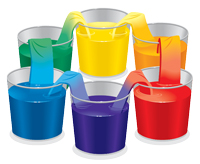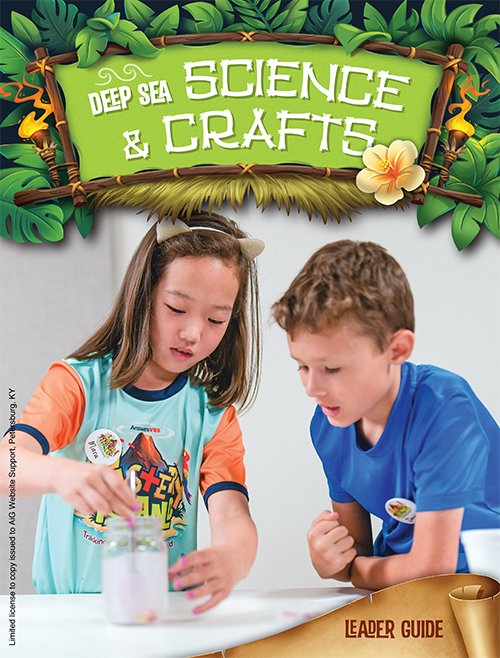Rainbow Water
Day One Experiment
on November 22, 2021; last updated November 30, 2021Materials (for every group of 3–4 students)

- 6 clear cups (5-oz. or 9-oz. clear plastic tumbler cups—see Tip Corner)
- Water
- Food coloring (Primary colors: red, blue, yellow)
- 6 half sheets of paper towels (Select-a-Size® works well)
- Optional: Straws
Pre-Prep
Fold a half sheet of paper towel in half lengthwise and in half again lengthwise. Trim off excess so that there isn’t too much paper towel that will stick up in the air between each cup. Repeat with the other paper towels and set aside. Put the six cups in a circle. Fill the first, third, and fifth cups with water, ¾ of the way full. Add five drops of red food coloring to the first cup. Add five drops of yellow food coloring to the third cup. Add five drops of blue food coloring to the fifth cup. The second, fourth, and sixth cups should be empty.
Teaching Tie-In
What’s your favorite color? I’m so glad the world isn’t just black and white, aren’t you? God’s colorful world is awesome!
Today, we’re going to figure out a mystery—what new colors will form in the empty cups? But before we do, let’s remember this about all science experiments: God is the one who made the laws of science. He designed and created them all. And his laws won’t change, because God doesn’t change. If these laws were true thousands of years ago, they are true today and will be true forever. It’s awesome to know that in a world where things can change and even be hard sometimes, God never changes and is always good. His goodness even includes making the world in color! Let’s see how we can make colored water “walk” to other cups and turn into new mystery colors.
Class Time Directions
Some of you said yellow, red, or blue were your favorite colors. Those three colors are called primary colors. Some of you said orange, green, or purple were your favorite colors. Those colors are called secondary colors. Our goal for today is to make orange, green, and purple appear in the empty cups on our table. How do you think we can do that? Take answers. That’s right! Secondary colors like orange, green, and purple are made by mixing together different combinations of yellow, red, and blue.
Today we’re going to watch the colored water travel to the empty cups and make new colors there—without even having to mix the water ourselves! There’s a big word scientists use to describe the water traveling from one cup to the other, and it’s called capillary action. Not caterpillar, but capillary. Capillary action means water can move through other materials. However, water can’t travel through just anything. In order to make water travel from the filled cup to the empty cup using capillary action, we have to find the right material that water can travel through.
As an option, the leader can demonstrate one or more different materials, such as a straw, before demonstrating the paper towel.
We’re going to use paper towels to watch the water travel from the full cups to the empty cups. Let’s place the ends of the folded paper towels in adjacent cups. Do so, making sure the ends of each paper towel are about one half to one inch from the bottom of the two cups it straddles. Now we’ll keep an eye on it so we can watch the colored water crawl up the paper towel and “walk” into the empty cup. Each set of primary colors (yellow, red, and blue) will mix to form secondary colors (orange, green, and purple).
Based upon the quality of the paper towels, this should take about 10 minutes. You can do something else while waiting, such as a simple craft, another experiment, a memory verse game, etc. Have them keep an eye on the paper towels. Ask the islanders which secondary color every two primary colors combine to make. Thank God for being a wonderful Creator who made the world in color.
Tip Corner
- Smaller cups allow the experiment to go a little faster. They must be clear.
- The test churches found that lower quality paper towels seemed to work better.
- If time, you may want to give the kids crayons and blank paper to make a color wheel. They need just yellow, red, and blue crayons. Make a circle with six pie-shaped wedges. Color wedge #1 yellow. Skip a wedge. Color wedge #3 red. Skip a wedge. Color wedge #5 blue. Then, using the yellow and red crayons, color wedge #2. It should make orange. Using the red and blue crayons, color wedge #4. It should make purple. Using the blue and yellow crayons, color wedge #6. It should make green.
- A science term introduced today is capillary action.
Mystery Island Deep Sea Science & Crafts
Kids love science experiments and crafts! This guide contains everything you need to coordinate the daily science experiments and crafts for all age groups.
Browse Kids Book- © 2024 Answers in Genesis
- Privacy Policy
- Contact
- About

